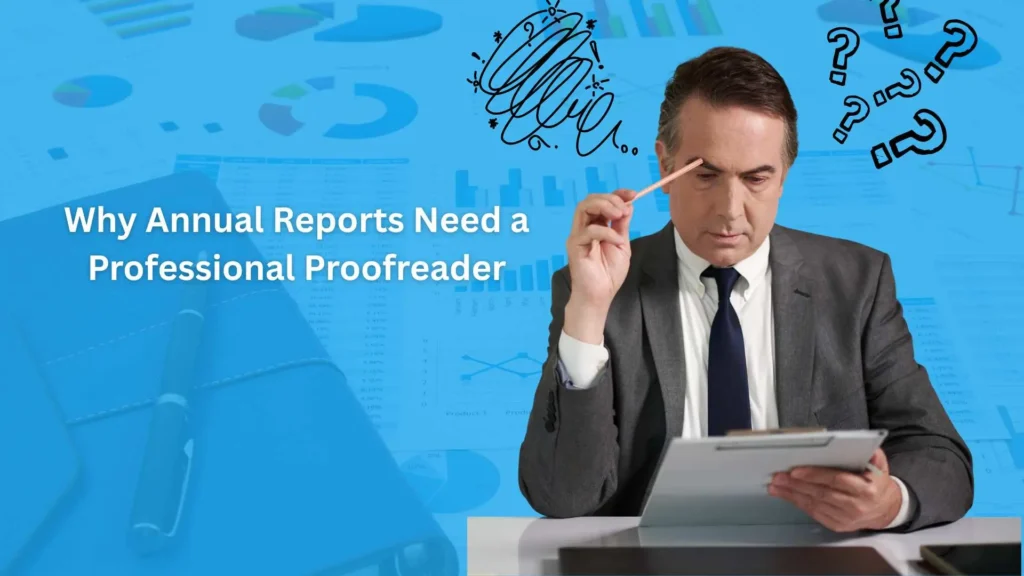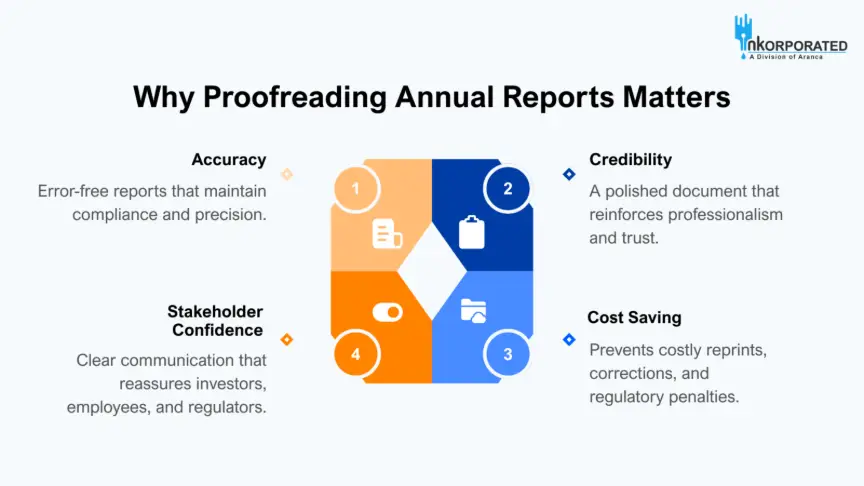Annual reports are not just statutory requirements-they are strategic documents that showcase a company’s integrity, performance, and long-term vision. These reports are scrutinized by investors, regulators, analysts, and employees. They can significantly influence the perception of an organization. However, even a minor typographical error or an ambiguous sentence can undermine confidence. This is why annual reports demand the precision and expertise of a professional proofreader-someone who ensures accuracy, clarity, and consistency throughout the document.
In the era of heightened corporate transparency, annual report proofreading has become a core part of investor relations, corporate governance, and brand reputation management.
Why Annual Report Proofreading Is Essential for Accuracy and Trust
Annual reports carry unique weight compared with other corporate communications. They combine financial disclosures, strategic messaging, and regulatory compliance in one publication.
Because these documents serve as both legal filings and marketing tools, the proofreading process directly impacts shareholder trust and long-term brand equity.
How Errors in Annual Reports Undermine Corporate Credibility
An annual report serves as a public statement of credibility. Any error-whether grammatical, numerical, or stylistic-can convey carelessness. For industries where trust is paramount, even small mistakes may be perceived as a lack of diligence, potentially damaging the brand.
Proofreading errors in annual reports don’t just affect grammar; they shape investor sentiment, influence analyst coverage, and even impact share price perception.
Compliance, Accuracy, and Risk Management in Annual Reports
These reports often contain legally required information, from audited financial statements to risk disclosures. A professional proofreader ensures that terminology, figures, and disclosures remain consistent and accurate. This reduces the risk of misreporting, regulatory penalties, and reputational fallout.
In regulated industries like finance, healthcare, and energy, compliance proofreading also helps align documents with frameworks such as IFRS, GAAP, and SEC reporting requirements.
Why Annual Reports Demand Extra Care in Proofreading
Annual reports do not simply disappear once they are past their publication date-they live on in corporate websites, in investor archives, and in regulatory filings.
This permanence makes proofreading critical: mistakes can be screenshotted, shared online, and preserved in media coverage, long after the correction has been issued.
High Visibility and Long-Term Impact of Errors
Once released, they become permanent public records. Errors, when discovered, can be circulated widely and may remain accessible for years.
Once released, they become permanent public records. Errors, when discovered, can be circulated widely and may remain accessible for years.
Real-World Example: When Annual Report Errors Trigger Damage Control
Several companies have had to issue clarifications when errors in their annual reports misstate financial results. Such corrections rarely erase reputational damage, and the cost of reprints or reissues can be substantial.
Investors, auditors, and journalists rarely forget these errors, which means proofreading acts as a safeguard against brand crises.
Why In-House Reviews Fall Short for Financial Documents
Companies often rely on internal reviews, but this approach has limitations.
The Problem of Internal Bias in Reviewing Annual Reports
Employees deeply familiar with the content can easily overlook errors. Familiarity narrows perspective and leads to blind spots. Professional proofreaders approach the document with fresh eyes and objectivity.
Overloaded Teams and Tight Reporting Deadlines
During reporting season, corporate communications and finance teams face tight deadlines and multiple responsibilities. Proofreading requires time and precision-luxuries that internal teams may not have. Outsourcing ensures focused attention and quality.
By outsourcing proofreading, firms gain both linguistic accuracy and financial document integrity, a combination not always achievable in-house.
Key Benefits of Professional Proofreading in Annual Reports
Hiring a proofreader goes beyond correcting typos; it elevates the overall quality of the report.
Enhancing Clarity, Readability, and Stakeholder Communication
Professional proofreading enhances clarity and readability by simplifying complex language, ensuring that even technical or financial terms are presented in a way that audiences in diverse geographies can easily understand. It improves sentence structure and flow, making information more accessible and engaging without diluting accuracy. Additionally, proofreaders eliminate ambiguities and redundancies, ensuring the annual report communicates its message with precision and impact.
Clear annual reports increase stakeholder engagement, improve readability, and strengthen overall corporate communication.
Adapting Annual Reports for Diverse Audiences
Annual reports are read by multiple stakeholders:
- Investors seek detailed financial data.
- Employees prefer straightforward explanations.
- Regulators require precision and compliance.
A proofreader ensures the report is understandable across these groups, balancing technical accuracy with accessibility.
Example: Financial vs. Non-Financial Readers
While investors may interpret EBITDA margins easily, employees or the public may need simpler explanations. A skilled proofreader bridges this gap without compromising accuracy.
Preserving Brand Voice and Consistency Across the Report
Consistent Corporate Identity
Proofreaders ensure consistency in:
- Tone and voice aligned with company values
- Spelling conventions (US vs. UK English)
- Formatting of numbers, dates, and percentages
Maintaining brand consistency across financial reporting reinforces professionalism and builds long-term trust with stakeholders.
Going Deeper: Style Guide Adherence
A style sheet tailored for annual reports guarantees uniformity across sections, tables, and appendices. This enhances readability and reinforces brand professionalism.
Risk Mitigation: Proofreading as Safeguard Against Financial Missteps
Errors in financial documents can have serious consequences. Professional proofreading helps mitigate risks by catching errors that could lead to misinterpretation, reputational damage, or even legal consequences.
In financial proofreading, accuracy equals credibility. A single misprint in earnings per share (EPS), debt ratios, or cash flow data can have regulatory and market implications. For example, in an annual report, a misplaced decimal point in revenue-such as reporting $50.0 million instead of $5.0 million-could mislead investors, distort financial performance, and expose the company to regulatory scrutiny. A professional proofreader acts as a safeguard, ensuring such inaccuracies are identified and corrected before publication.
Proofreading of the annual report can safeguard a company’s interests as the proofreader would:
- Cross-check numbers with context
- Flag inconsistencies across charts, graphs, and text
- Eliminate ambiguities that could mislead stakeholders
Professional Proofreading vs. Editing: What’s the Difference?
Understanding the difference between editing and proofreading is critical. Professional proofreading and editing serve different but complementary purposes. Editing focuses on improving flow, structure, and clarity, often reshaping content to enhance meaning and engagement. Proofreading, on the other hand, is the final quality check that eliminates grammatical errors, formatting inconsistencies, and typographical mistakes before publication.
Framing proofreading as the final “compliance safety net” highlights its role not just in grammar correction but in protecting against legal, financial, and reputational risks.
Proofreading: The Final Quality Check Before Publication
Proofreading focuses on surface-level issues such as grammar, punctuation, formatting, and typographical consistency. It is the last stage before publication.
Example of Proofreading Checks
- Ensuring figures in charts match narrative text.
- Correcting alignment and spacing.
- Fixing minor errors overlooked during editing.
Editing: Restructuring Content for Flow and Engagement
Editing occurs earlier in the process and focuses on restructuring sentences, improving flow, and clarifying meaning. Proofreading complements editing by ensuring the document is error-free and publication-ready.
The Proofreader’s Toolkit: Technology Meets Human Expertise
Professional proofreaders bring both technological tools and human expertise. The proofreader’s toolkit combines advanced digital tools-such as grammar checkers, style guides, and consistency software-with human expertise to ensure precision and nuance. While technology detects surface errors, a proofreader’s judgment ensures context, tone, and industry-specific accuracy.
This hybrid of human + digital tools is what makes annual report proofreading future-ready, balancing AI-driven checks with human editorial judgment.
Digital Tools
- Advanced spelling and grammar checkers
- Style and readability software
- Tools for consistency in terminology and abbreviations
Human Expertise
Technology detects obvious mistakes, but professional judgment ensures context, nuance, and industry-specific terminology are correct. A proofreader knows when numbers look suspicious or when tone strays from brand identity.
The ROI of Professional Proofreading in Annual Reports
Investing in proofreading services yields measurable and intangible returns. In ROI terms, proofreading annual reports is not a cost-it’s a reputational investment, ensuring transparency, compliance, and investor confidence.
Financial Savings Through Accuracy and Error Prevention
- Avoids costly reprints.
- Reduces risk of regulatory fines.
- Minimizes time spent on corrections post-publication.
Enhanced Credibility and Investor Confidence
A polished annual report demonstrates professionalism, reassures investors, and builds confidence in leadership.
Building Long-Term Stakeholder Trust Through Transparency
Trust is a long-term asset. By producing error-free reports, companies reinforce their commitment to accuracy and transparency-qualities that resonate strongly with stakeholders.
Final Thoughts: Annual Report Proofreading as a Strategic Investment
An annual report is more than a compliance obligation-it is a company’s flagship communication piece. It presents performance, outlines future goals, and reflects accountability. Treating annual report proofreading as a strategic investment positions companies as transparent, trustworthy, and detail-oriented in the eyes of stakeholders. Given its importance, no organization can afford mistakes that diminish credibility.
Professional proofreaders ensure accuracy, clarity, and consistency, transforming an annual report from a routine document into a strategic communication asset. By investing in proofreading, companies protect their reputation, enhance transparency, and build trust with stakeholders.
For organizations committed to excellence, annual reports should never go to print-or online-without the final touch of a professional proofreader.
Want to learn how our proofreading services can make your next annual report flawless? Contact Us today!
Want to see how financial terms shift meaning between daily life and the markets? Check out our latest LinkedIn carousel here.


